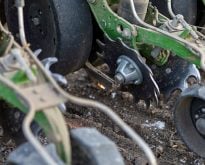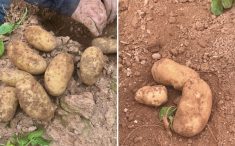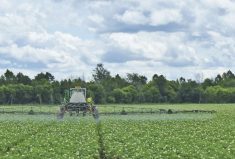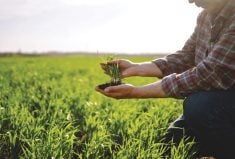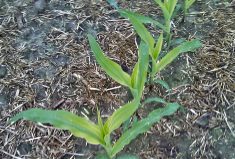The air around us and in every nook and cranny between soil particles is 78 per cent nitrogen, yet farmers pay billions per year for N fertilizer. Wouldn’t it be great if we could find efficient, low-cost, hard-working bacteria to convert nitrogen in the air into an available form of N for any crop — canola, corn, wheat, whatever?
I asked this question again after receiving an announcement in February that a company had launched “the only N-fixing bacteria that works from within the plant cells to fix nitrogen all season long.”
Read Also

Producers aren’t panicking over tariffs and trade threats
The influence of tariff and trade uncertainity on farm business decisions.
I forwarded the announcement to John Heard, soil fertility extension specialist with Manitoba Agriculture. “Aren’t we all waiting for a generalist bacteria to convert N in the air to plant-available nutrient?” I wrote. “Or is that like waiting for someone to invent a perpetual-motion machine or see a unicorn?”
“Great news!” Heard replied. “Yes, we have anxiously been waiting for this!”
The exclamation points were a dead giveaway. I called him to hear the inflection in his voice. As I figured, he was being sarcastic… but not entirely.
Heard made two important points. One, he expects that a truly effective generalist N-fixer will be found.
“Someone someday will discover this bacteria. Is this the one?” Heard asked. “The problem is the marketplace is so cluttered with startups, we may never know when we have it right.”

Because efficacy testing is no longer required for registration of a crop nutrition product in Canada, products come to market well before anyone can think about third-party unbiased research, he says. “And if scientists were to do the public research, which of the many products do they choose to study?”
As a part B to point one, Heard reminds farmers to judge all product claims with a critical mind. It may come down to diligent on-farm research to see which products work, reduce risk and improve profitability. (See ‘How to’ at bottom for more on on-farm trials.)
The negatives?
For his point two, Heard asks whether there any downsides to this bacteria. Say it works really well in the greenhouse. These bacteria pull nitrogen out of the air with amazing efficiency. Then you release it into the fields and it works really, really well. Too well. These bacteria churn out so much plant-available nitrate that crops can’t possibly use it all, and this nitrogen builds up in lakes and nitrous oxides escape into the atmosphere. “When you put it out into the field, then the genie is out of the bottle,” Heard says.
What we probably want is a generalist N-fixer that works just well enough to take the edge off high N-rates and to provide a little N boost later in the season. The new product announced in February might fit that “take the edge off” description.
In its on-farm corn and soybean trials in 2018, the company says that over 80 per cent of trials achieved a yield increase when the product was used in addition to the farm’s regular fertility program, and the average increase was seven bushels per acre — good, but based on those results, it won’t replace nitrogen fertilizer.
Borlaug’s dream
I’m not going to name the company or the product because, as Heard noted, there are so many new crop-nutrition products and this one has not gone through any third-party trials in Canada. But with Heard’s help, I tracked down the U.K. scientist who led the discovery and licensed it to the company that brought it to market.
He is Edward Cocking, a research scientist at the Centre for Crop Nitrogen Fixation at the University of Nottingham. Cocking shared “The Greener Nitrogen Revolution” report which he presented to the International Fertilizer Society conference in 2017. He wrote that researchers have been looking for a generalist N-fixer since at least 1893 and that Nobel Prize winner Norman Borlaug saw it as the next step in his fertilizer-driven Green Revolution.
Cocking included this Borlaug quote in his report: “In my dream, I see green, vigorous, high-yielding fields of wheat, rice, maize, sorghum and millet which are obtaining, free of expense, 100 kilograms of nitrogen per hectare from nodule-forming, nitrogen-fixing bacteria.”
Nodulation not needed
In his pursuit of the Borlaug dream, Cocking found nodulation — the process used for N capture in pulses — is not needed for nitrogen fixing. His bacteria, called Gluconacetobacter diazotrophicus (Gd), was first found on sugarcane and doesn’t form nodules at all.
“Nodulation was not a necessary step and is very much a red herring,” Cocking says. “A key need is for the nitrogen-fixing bacteria to become intracellular, and for plant cells to become a habitat for such nitrogen-fixing bacteria.”
Cocking also discovered that Gd worked within cells located anywhere in the plant, including in the leaves.
“This is very significant,” he says, “because it results in Gd and chloroplasts being very closely associated in leaf cells, enabling improved photosynthetic efficiency, more nitrogen fixation and increased yields.”
Gd can be applied on-seed or into the soil. In light of John Heard’s N-spewing disaster scenario, I asked Cocking about the risk that such a bacteria could take over the soil microbiome and churn out climate-changing amounts of nitrous oxide.
“Gd is an obligate endophyte living within the plant, and does not survive in the soil,” he says. “For instance, it has not spread in nature from sugarcane plants. There is no evidence for it taking over the soil microbiome.”
Finally, I asked Cocking where the Gd discovery sits on the Billboard Top 100 of agriculture discoveries?
“My Gd discovery and its commercial development and application would sit at the top of the Billboard Top 100 of agriculture discoveries, alongside Fritz Haber’s discovery of the chemical synthesis of ammonia from hydrogen and nitrogen,” he says, adding, “There is nothing similar in the works. Our strain of Gd is a gift of nature, and the methodology used is imitating the dictum of Leonardo da Vinci — look first to nature before invention.”
The company with the license for commercial development of Cocking’s Gd product has been doing its own research on corn and soybeans in the U.S. and Ontario and will expand into canola in 2019. It hopes for Canadian registration in 2020. If Cocking’s discovery is the generalist N-fixer we’ve been waiting for, it won’t take long for everyone to hear of it, to use it and to celebrate the greener nitrogen revolution it represents.
When that happens, John Heard will shout “Great news!” and might really mean it.
How to do an on-farm research trial
1. Determine the hypothesis to test — in this case, whether a new crop-nutrition product works. The trial will compare the control (what you usually do) and the treatment (what you usually do plus the new treatment).
2. Design the experiment. The most common design in research is the randomized complete block design (RCBD). Treatments are randomly arranged within separate strips of the field. The strips can be located in separate areas of the field, separate fields or even separate years provided that both treatments are represented in each strip. Another option is the paired T-test, which may be as simple as leaving a couple of check strips throughout the field.
3. Run the test. Locate trials in representative areas of the field and try to choose fields that are most representative of the farm. A minimum of three replications is recommended and, as previously mentioned, data from different fields or years may be combined to increase replication. Be sure to treat both treatments the same in every respect except for the factor being tested. Making each plot at least two times the width of the swather or combine which will be used for the field helps to ensure that one harvest pass falls entirely within the plot. Accurately mark each strip so that the treatments can be monitored throughout the season and so that you know when you are approaching the test area at harvest.
4. Collect the data accurately and without bias. Use weigh wagons if possible for each strip and make sure each harvested area is exactly the same size for easier and more accurate yield determination. Enter results in a data analysis tool.
These steps are from the Indian Head Agriculture Research Foundation’s On-Farm Research Guide. The IHARF website also has an Excel-based interactive data analysis tool. For another option, you can find test-specific on-farm research protocols, including for nitrogen rate or foliar product trials, at ultimatecanolachallenge.ca.



